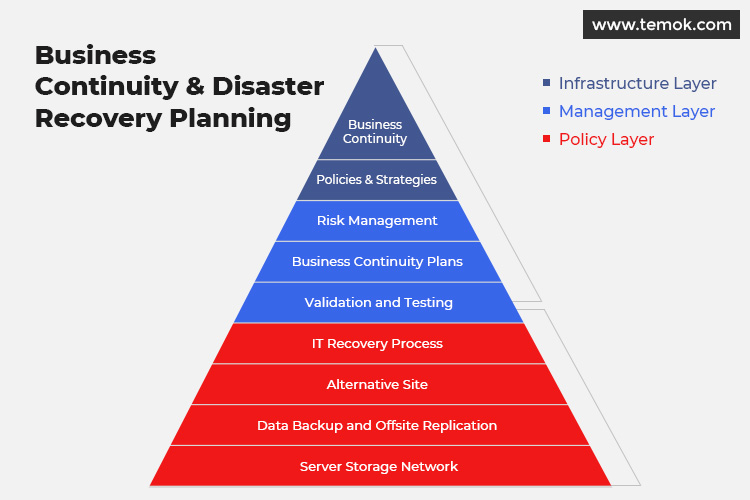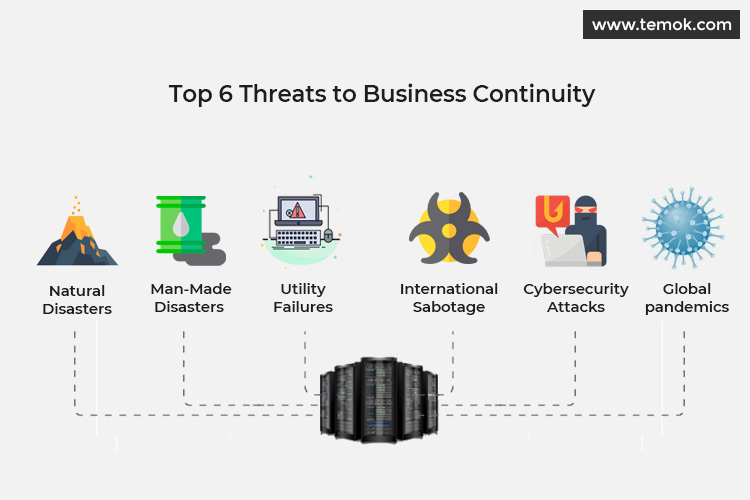In Business Continuity Planning One Must Test the Disaster Recovery Plan Before Implementing It
7 min read
Running an online business without implementing business continuity and disaster recovery plan is very dangerous to approach. If you are thinking to earn a handsome amount of profit without putting protections then you can't run your long-term business plan in a proactive manner.
Business continuity is based on different plans of action that ensure the regular business will perform its operations during a disaster. However, disaster recovery is a subset of business continuity planning. In this article, you will learn all the basics of a business continuity plan, different threats, and how to protect your assets using proactive techniques with the help of a business continuity and disaster recovery checklist.
What is Business Continuity and Disaster Recovery Plan?
Business Continuity Plan is the process of creating systems that will help to prevent threats and aiding in the recovery processes. Business operations face many types of disasters like floods, tornadoes, earthquakes, poor monetary policies and many others that can completely or partially interrupt the operations. Business continuity plan used to restore the interrupted business operations or services.
Disaster Recovery Plan is a set of procedures, documents and structured approaches to execute an organization's disaster recovery process and help to protect the IT infrastructure to quickly resume the business operations after an unplanned incident.

Why is Business Continuity and Disaster Recovery Essential?
The main role of business continuity and disaster recovery is to minimize the effects of disruptions on business operations. It also enables the organizations to perform their operations after any problem occurs and decrease the data loss risks. BCDR includes crisis management, alternative work locations, employee safety and many other operations that are necessary for any organization to survive after any bad condition.
You need to conduct a business impact analysis (BIA) that will identify the opportunities for improving the processes and help in better use of technology. In order to build an effective BCDR strategy, you need to plan the documents that will also help you to get valuable information like employee contact lists, vendor lists, technical diagrams of networks and systems, equipment lists and many others to perform better resource management.
This plan can also serve as an alternative source of documentation and key contact information. Simply, it is a reference document that is also helpful in product planning, design, delivery and many other activities. A good plan can save the time of any organization in any emergency situation and help to fix the disruptions within a short time period.
Business Continuity Plan Life Cycle

Business Continuity and Disaster Recovery Checklist
According to the Federal Emergency Management Agency (FEMA), 40% of small businesses can never recover from a disaster, so you need to build business continuity and disaster recovery plan in order to survive.
Successful business continuity and disaster recovery plan are based on an in-depth understanding of the impact of the disastrous situation on any business. Use the following information, it will help you to prepare a comprehensive plan. Each organization has particular disasters based on geographical location, company structure, environment, system and security.
1. Drawing Up the BCP Plan
Mapping out a strategy is an important component of any great business continuity plan. Every successful business or organization draws plans in order to make an important business strategy. In this plan, organizations make a list of disruptions that can affect the company and identify the key processes and people who will keep it running.
2. Conduct Business Impact Analysis (BIA)
When you have identified all the potential threats, you need to be thoroughly analyzed. In proper BIA (business impact analysis), extensive lists may need to be prepared based on the organizations' set up and geographical location. These lists include floods, fires, volcanoes, hurricanes and even Tsunamis, cyberattacks, data corruption, downtime due to power failure, hardware faults, system failures and other malicious threats to data security.
3. Educate Your Employees
If your employees have proper education and training, there are minimum chances to get data braches. Develop a comprehensive training program in order to help your technical team in developing the required skill set.
When you have identified all the disastrous scenarios that your organization can face, provide training to your employees about what they should do in these specific circumstances. Many big organizations conduct fire and earthquake training to all workers about what to do during these conditions. Make sure to provide all the necessary information about various disastrous situations.
4. Isolate Sensitive Information
You need to isolate your confidential data in order to prevent data breaches. Private data, such as financial records and other critical information such as login credentials, require safe storage where recovery is convenient.
5. Test, Measure, and Update
Every main business program should be tested, measured and updated for its effectiveness. Testing should include the execution of a particular task using simulations to test the team's level of preparedness during a crisis. After these results, you can make additional modifications.

6. Identify Critical Business Functions
First of all, identify the business process and critical functions that are most important for your daily operations. In case of any disaster, which business process should remain functional will be your key consideration. Enlist all business functions including manual and automated. Now, identify the effects of each function, it will help you to understand the priority of critical business functions.
7. Essential Equipment
On-floor computer machines have critical client information and important files. So, loss or any damage to these machines can greatly impact on client relations and business productivity. It is a better approach to identify computing machines or other equipment that are most important such as servers and special equipment.
8. Potential Threats and Possible Risks
When you have started to build a proactive business continuity strategy then try to cover maximum types of crises and threats. Enlist all the possible threats that have an impact on your business processes and prioritize them according to the possibility of occurrence.
Floods, earthquakes, and hurricanes may destroy both human life and property. However, the cyber-attacks may destroy your IT infrastructure but they can't steal your hardware. Power outages can decrease your productivity rather than having an impact on your resources. Create a business continuity and disaster recovery strategy that will cover a maximum number of possible events.
9. Emergency Contact Information
Search on Google and prepare a list of nearest police stations, rescue offices, hospitals, fire station and other government entities that can give you a quick response in case of any emergency. You can also save this list on different storage mediums so that you can easily contact in case of any disaster.
10. Disaster Recovery Team
Most of the organizations don't implement business continuity and disaster recovery plans in daily operations, so the team is generally part of the operations management department. The disaster recovery team should base on the top management of different departments because the whole organization needs to be involved in this business plan. This team initially responds in case of any disastrous event.
11. Roles and Responsibilities
Don't forget to assign a specific role or responsibility to each member of the disaster recovery team. Before assigning roles, understand their expertise and skill to give every responsibility to a person who is capable to handle in an efficient manner.
In case of any cybersecurity or IT disasters, the IT professionals should respond. If you have no employee having medical background then conduct training of first aid, so that they can provide initial treatment to your employees.
12. Data Backups
Almost every online business has sensitive and confidential data that you will protect and secure on the highest priorities. In order to prevent these disastrous situations, you can use the cloud storage for taking your regular data backups. If you are facing any disaster, you can easily use your data backup from all over the world using cloud access.
13. Alternatives Office
If your office building is rendered unusable, so you can use another backup location from where you can start your business immediately. It can be a store, hostel, spare office, or any residential house. You have thousands of employees that can never be sitting in the alternative space then identify those employees that can work from home and telecommunicate efficiently with the team. Enlist the employees having their own workstations, laptops so that they can easily continue their work with better collaboration.
14. Alternative Communications
During any disaster, the internet is damaged then assigns a safe rally point where your workers can converge. In this way, you can take account of all your employees during and after a disaster.
With a great BCP (Business Continuity Plan) you can prevent your company and quickly recover from any disaster. You can't control the natural calamities or events that are not in your control but you can implement effective strategies to recover your business.
Top 6 Threats to Business Continuity

Following are the most common threats that every company can face:
1. Global Pandemics
These types of threats can cause huge issues for organizations including the reduced labor supply, availability of temporary employees, client orders canceled, interruptions in getting the supply of materials, reduction in public meetings, reduced availability of health care, telecommunications problems, water, fuels and many more. You can overcome these type of issues if have proper planning of the implementation of remotely work.
2. Natural Disasters
Natural disasters have also a significant impact on human health and safety, workspaces, resources, property, supplier transactions, communication processes, the confidentiality of information and company infrastructure. Major natural disasters are based on natural phenomena like floods, earthquakes, wildfires, tornadoes, hurricanes and winter storms.
3. Man-made Disasters
These types of disasters are caused by human negligence, mistake or accident including, chemical explosions, wrong electricity connection, gas leaks, oil spills, factory fires or improper disposal of waste. If you conduct proper workshops and technical training then you can overcome the human errors and prevent your organization from any major loss.
4. Utility Failures
This disaster occurs when any utility provider can't provide services for any reason or failure. Main utility failures are electricity failure, loss of communication or internet lines, or disruption of water supplies.

5. Intentional Sabotage
Intentional sabotage is the act you commit with the intent of putting the business at risk including a bomb threat, arson, financial, or confidential information leaks. You can overcome this risk by involving human resources.
6. Cybersecurity Attacks
Any unauthorized access to confidential data is known as cybersecurity attacks. It is performed by an attacker or hacker using loopholes in your network, or any other resources. The most commonly used cybersecurity attacks are information leaks, ransomware, and denial of service attacks or SQL injection attacks.
They perform data breaches and sell useful information on the black web. You can prevent cybersecurity attacks by implementing proactive approaches.
Conclusion
Become proactive and implement all these strategies in order to survive in case of any disaster. With improper business continuity and disaster recovery plan, you can experience a big loss. It is necessary for every organization to have long-term business planning.
barnestuslies1976.blogspot.com
Source: https://www.temok.com/blog/business-continuity-and-disaster-recovery/
0 Response to "In Business Continuity Planning One Must Test the Disaster Recovery Plan Before Implementing It"
Post a Comment